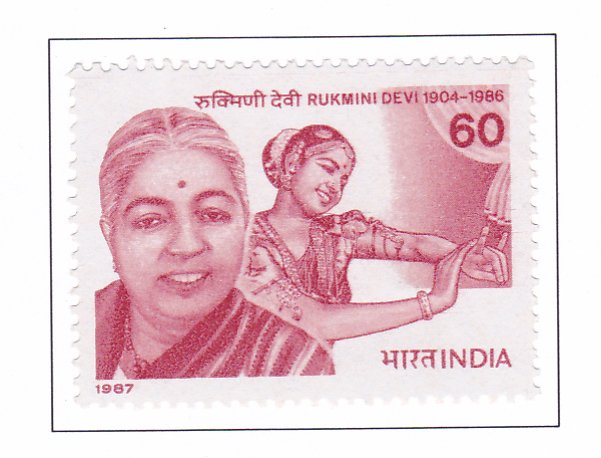Rukmini Devi 1904-1986

Technical Data
| Date of Issue | December 27, 1987 |
|---|---|
| Denomination | 60 p |
| Quantity | 1,000,000 |
| Perforation | comb 13½ x 13 |
| Printer | Security Printing Press, Nashik |
| Watermark | No Watermark |
| Colors | Deep red pink |
| Catalog Codes |
Michel IN 1134 Stamp Number IN 1196 Yvert et Tellier IN 951 Stanley Gibbons IN 1283 |
| Themes | Commemoration | Dance | Famous people | Folklore | Politicians | Suits and Costumes | Women |
Commemorative Stamp: Rukmini Devi
Design Elements:
- Central Image: A graceful portrait of Rukmini Devi in a traditional Bharatanatyam pose, embodying the elegance and spirit of Indian classical dance.
- Background: Elements of the Kalakshetra campus, including its architecture and lush surroundings, symbolizing the institution she founded.
- Symbols: Iconography representing Bharatanatyam, such as mudras (hand gestures) and traditional dance attire, along with symbols of Theosophy and humanitarian causes.
Cultural and Historical Significance:
Rukmini Devi was born on 29th February 1904 into a South Indian family known for its cultural and scholarly traditions. Her parents were deeply influenced by the Theosophical Movement, a philosophy that shaped her life and work. Her marriage to Dr. G.S. Arundale further deepened her involvement in Theosophy.
A transformative meeting with Anna Pavlova, the renowned Russian ballerina, sparked Rukmini Devi’s passion for dance. Despite facing significant opposition, she dedicated herself to mastering Bharatanatyam, driven by a desire to revive and preserve this ancient art form among the youth. This mission led to the founding of Kalakshetra in 1936, an institution that has since become a premier center for the arts in India, offering instruction in dance, music, sculpture, and crafts in a Gurukula atmosphere.
Under Rukmini Devi’s leadership, Kalakshetra maintained the purity and beauty of India’s great artistic traditions, combined with the highest standards of technique and learning. She pioneered a new genre based on old traditions—the Dance Drama—and choreographed 25 such productions.
Her contributions extended beyond the arts. She invited Dr. Maria Montessori to India, leading to the establishment of the first Montessori School and teacher training courses in the country. As a member of the Rajya Sabha in 1952, Rukmini Devi introduced the Bill for the Prevention of Cruelty to Animals, resulting in the formation of the Animal Welfare Board of India, with her as the chairman.
Rukmini Devi’s efforts in education, humanitarian work, and the arts were recognized through numerous honors, both in India and abroad. These include the Padma Bhushan, Fellowship of the Sangeet Natak Akademi, the Queen Victoria Silver Medal from the Royal Society for the Prevention of Cruelty to Animals, the Deshikothama from Visva-Bharati University, the Thanipperum Kalaignar Award from the Tamil Nadu Eyal Isai Nataka Manram, and the Kalidas Samman by the Madhya Pradesh Government.
Usage:
The stamp celebrates Rukmini Devi’s multifaceted contributions to Indian culture, education, and humanitarian efforts. It serves both postal purposes and as an educational tool, spreading awareness of her legacy and inspiring future generations.
Example of the Stamp Design:
- Main Stamp: Featuring Rukmini Devi in a Bharatanatyam pose, capturing her elegance and dedication to the art form.
- Supplementary Stamps:
- One stamp showcasing the Kalakshetra campus, symbolizing the institution she founded.
- Another depicting the Montessori School and teacher training courses she established in India.
- A third stamp illustrating her involvement in humanitarian efforts, such as animal welfare and the Theosophical Movement.
Significance:
This commemorative stamp set honors Rukmini Devi’s legacy as a pioneering dancer, educator, and humanitarian. It highlights her contributions to the revival of Bharatanatyam, her efforts in education and animal welfare, and her role in promoting theosophical and humanitarian values. The stamp set serves as a tribute to her visionary work and enduring influence on Indian culture and society.
